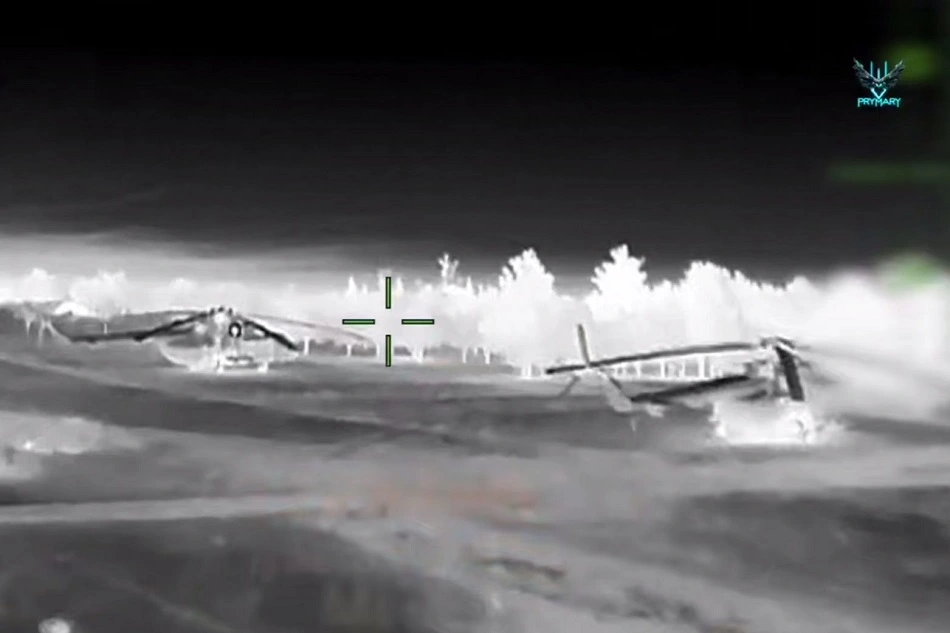In a precision strike that underscores Kyiv’s mastery of low-cost, high-impact warfare, Ukrainian special forces obliterated three Russian Mi-8 helicopters and a sophisticated radar system, dealing a multimillion-dollar blow to Moscow’s grip on the annexed peninsula.
CRIMEA — Under the veil of night in Russian-occupied Crimea, a shadowy Ukrainian sabotage unit known as Prymary slipped past layers of defenses to unleash a barrage of first-person-view (FPV) drones on high-value targets, writes DROBRO. The operation, executed by Ukraine’s Main Intelligence Directorate (GUR), reduced three multipurpose Mi-8 helicopters to smoldering wreckage and vaporized a state-of-the-art 55Zh6U “Nebo-U” radar station — a system prized for its ability to detect stealth aircraft and missiles from hundreds of miles away. Footage released on GUR’s official Telegram channel captured the inferno in stark detail: rotors twisting in flames, twisted metal scattering across the airfield, and the radar’s skeletal remains crumpling like foil.
The combined losses? An estimated $130 million, a stark reminder that in the third year of Russia’s invasion, Ukraine’s ingenuity is turning the tide one drone at a time.
The raid, which GUR described as part of an unrelenting campaign to erode Russian aviation capabilities in Crimea, highlights Kyiv’s pivot to asymmetric tactics amid ammunition shortages and stalled Western aid. Each Mi-8, a Soviet-era workhorse repurposed for transport, assault, and evacuation by Russian forces, fetches $10 million to $15 million new — putting the trio’s destruction at $30 million to $45 million alone. But the real prize was the Nebo-U, a mobile radar worth up to $100 million, capable of scanning airspace over 2,000 square miles and integrating with Moscow’s layered air defenses. “The armed struggle continues,” GUR stated laconically in its release, a phrase that belies the operation’s audacity: Prymary operatives, operating from hidden launch points on the mainland, guided the FPV drones — essentially modified commercial quadcopters packed with explosives — via real-time video feeds to their marks with surgical precision.
💥🔥 Prymary ГУР хвацько залетіли до Криму і спалили техніку ворога на 130 млн. доларів (Відео)https://t.co/E4UStiOmD9 pic.twitter.com/YbnkgDLPpW
— Дрогобич чиНа ❗️ DroBro7/24 (@DroBro10) September 21, 2025
Crimea, annexed by Russia in 2014 and a linchpin of its Black Sea strategy, has become a cauldron of Ukrainian reprisals. Just weeks ago, Ukrainian forces hammered Sevastopol’s naval base with Western-supplied Storm Shadow cruise missiles, sinking warships and forcing Russia’s Black Sea Fleet into a defensive crouch. Those Anglo-French munitions, with their 155-mile range and terrain-hugging flight paths, have rendered much of the peninsula unsafe for Russian assets — a point driven home when they cratered the fleet’s headquarters in September 2023, killing a top admiral. Now, with FPV drones extending the reach of such strikes at a fraction of the cost — $500 per unit versus millions for a Storm Shadow — Ukraine is democratizing destruction. “These aren’t just gadgets; they’re equalizers,” said a Western defense analyst who tracks GUR operations and spoke on condition of anonymity. “Russia’s vaunted air superiority is eroding, one cheap hit at a time.”
The broader implications ripple far beyond the Crimean tarmac. Moscow’s aviation losses in the peninsula — now numbering in the dozens since the invasion’s outset — complicate its glide-bomb campaigns terrorizing Ukrainian cities and front lines. In recent months, Russian Su-34 bombers, shielded by Crimean radars like the Nebo-U, have unleashed thousands of unguided munitions on Kharkiv and Kherson, killing civilians and pulverizing infrastructure.
By torching these assets, Prymary not only disrupts logistics but sows paranoia among Russian commanders, who must now fortify every hangar and antenna. Russia’s Defense Ministry, true to form, has downplayed the strike, claiming “minimal damage” from “terrorist drones” — a narrative echoed in state media that omits the video evidence circulating on pro-Ukrainian channels. Yet, independent verifiers, including satellite imagery from open-source intelligence firms, corroborate the devastation, with thermal signatures lingering for hours.
For the Ukrainian operators behind Prymary — elite scouts and drone pilots drawn from GUR’s Timur and Atesh networks — such missions are a high-wire act of patriotism and peril. Recruited from Crimean Tatar communities and Kyiv’s tech-savvy youth, they navigate minefields of electronic jamming and betrayal risks, often relying on smuggled components and Starlink uplinks. One former operative, now in exile, told The Washington Post: “We fly these birds into the dragon’s mouth because Crimea is ours. Every fire we light is a step toward home.” Their success owes much to Western tech transfers: FPV guidance systems refined with U.S. and British software, even as debates rage in Washington over escalating aid amid election-year politics.
As autumn chills the front lines, this Crimean conflagration signals no thaw in the war’s ferocity. With Russia amassing North Korean mercenaries and probing Kursk incursions, Ukraine’s drone swarms — from FPV kamikazes to maritime marauders like the TLK-1000 unveiled in Lviv last week — are proving that innovation, not just firepower, wins endurance tests. For Moscow, the message is unequivocal: Annexation’s price tag is climbing, and the bill is being footed in flames. As GUR’s footage fades to black, one thing endures — the hum of drones on the horizon, heralding the next strike in a conflict that defies easy endings.
